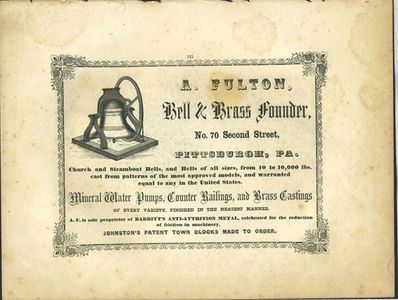Fulton bell foundry
The History
The A. Fulton Bell & Brass Foundry of Pittsburgh, PA. was formed as a partnership agreement between Andrew Fulton and Hugh Gallager in 1828 for casting bells, pumps and other bronze and brass goods. It not much is known about the early days of this foundry but it is documented that in 1845 the foundry burned down. Andrew was able to rebuild the foundry immediately, presumably with his own funds as the name of the company became A. Fulton & Company. The foundry quickly gained a reputation for casting some of the finest bells in America.
In 1864 Andrew retired from the foundry and his son and nephew took over operation of the foundry. Several years later in 1866 the name of the company was changed to Andrew Fulton & Sons. That same year the city of Pittsburgh requested the foundry cast a large bell of 4,000 Lbs. that would be used as a city fire bell. Andrew hearing of this because interested and returned to work to oversee that project as the foundry had never cast a bell of that size before. Because the size of this bell, the foundry was not equipped to cast it. The furnace was not large enough, the foundry pits deep enough, nor was the crane heavy duty enough. To create such a bell, Andrew reached out to a friend S. S. Fowler who owned a large machine shop close to the foundry. Mr. Fowler agreed to let them use his works to cast the bell. Unfortunately although the casting looked successful, the first attempt at casting was a failure. It is said that upon opening the mold, Andrew saw immediately that the casting was not good and that a portion of the mold had failed. A second attempt was made, this time successful, producing the bell perfectly. The large bell was hung in a fire tower located at Diamond and Ross Streets and was rung yearly in remembrance of the Great Fire of 1845. In 1892 the bell was removed from the tower and was later relocated in front of Historical Society where it remains today.
The foundry cast another large bell of approx. 3,000 Lbs. in 1870. It was commissioned for the clock tower of the Allegheny Cemetery office complex. It continues to toll daily—originally manually, now by automated mechanism—and has been rung for funerals, national events and memorial services.
In 1871 the foundry named was changed again, this time to A. Fulton Son & Company and changed again in 1884 to Chaplin Fulton LTD. The final name of the foundry came in 1891 when it was named Chaplin Fulton Manufacturing Company.
They remained active through the late 1800s into early 1900s from a location in downtown Pittsburgh and was a landmark in the city's Victorian industrial landscape.
One of the most interesting things about this foundry is that there never seemed to be a standard profile or shape of the bells they cast. Through the years they cast many different shapes of bells, some plain and some very decorative. Some bells had flat tops while others had cones or even crown tops. The foundry never cast a chime of bells and cast very few peals, but is well remembered for the beautiful bells they did produce.


ceCopyright © 2025 T Verdin Legacy Bellworks - All Rights Reserved.
This website uses cookies.
We use cookies to analyze website traffic and optimize your website experience. By accepting our use of cookies, your data will be aggregated with all other user data.